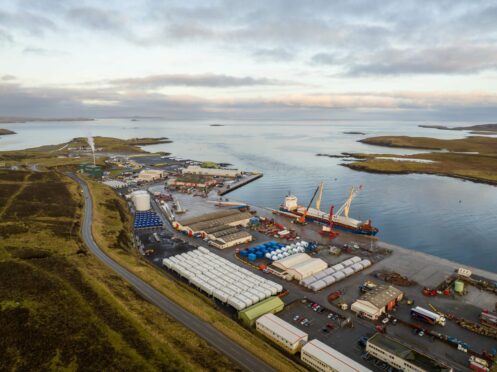Lerwick Port Authority is transforming Shetland into a clean energy centre, supporting offshore windfarm developments while remaining committed to the local fishing industry.
-
Some Press and Journal online content is funded by outside parties. The revenue from this helps to sustain our independent news gathering. You will always know if you are reading paid-for material as it will be clearly labelled as “Partnership” on the site and on social media channels.
This can take two different forms.
“Presented by”
This means the content has been paid for and produced by the named advertiser.
“In partnership with”
This means the content has been paid for and approved by the named advertiser but written and edited by our own commercial content team.
The early months of 2023 are providing a series of significant milestones in Lerwick Port Authority’s strategy to sustain and develop activity at the Shetland harbour and underpin its role in the islands’ economy in the future.
Captain Calum Grain’s, the Authority’s Chief Executive, said: “2023 has started well as we build on our recovery from the Covid-19 pandemic and look ahead with renewed confidence from increasing levels of shipping activity.
“We are responding to the challenges by taking steps to influence operations down the road.
“The positive outlook is encouraged by the port’s performance in 2022, with an improving picture across the range of sectors which Lerwick, with its versatile, modern facilities, serves.”
LPA helps transform Shetland into clean energy centre
The Authority’s ambitions in the renewable energy sector and its commitment to reducing its own carbon emissions have been complemented by becoming a strategic partner in the Shetland Islands Council-led ORION Project, aimed at transforming Shetland into a clean energy centre.
The port is seen to have an important contribution to make to the package Shetland offers to renewable energy developers through the transition, with the Authority aiming for a major role in providing and developing infrastructure and supporting the local supply chain.
The Authority is working on decarbonising its own operations, and working toward further facilities to increase shore power options for vessels and systems for clean bunkering.
Measures to protect the environment include supporting marine waste and waste oil recovery, emissions reductions, electrification of plant and equipment, and planting trees to offset paper usage through rewilding projects.
Lerwick Harbour: key to offshore windfarm developments
The harbour is also central to SSE Renewables development of the Viking onshore windfarm, taking delivery of components for the 4.2MW turbines, including towers, nacelles and 57-metre-long blades, with the cargoes from 22 shipments being stored at Greenhead Base over a period of months. Onward transportation to site is underway.
Also looking to the future, the Authority has already held constructive talks with operators awarded licences for new offshore windfarm developments immediately to the east of Shetland. Captain Grains said: “Long-term, there is huge potential in these projects, and we continue our discussions to ensure awareness of Lerwick’s capabilities, including our plans for an Ultra-Deep-Water Quay.”
These plans reached another milestone earlier this year with the formal signing of the Islands Growth Deal, between the Scottish and UK Governments and Shetland Islands, Orkney and Western Isles councils, which will contribute £9 million to the cost of the quay.
With the port’s Dales Voe identified in an independent study for the Scottish Government as the optimal UK location for the Ultra-Deep-Water Quay (UDWQ) to decommission larger oil and gas platforms, it is now also recognised as a key location for assembly and deployment of large-scale floating structures for offshore windfarms.
Estimated to cost £34 million, the 100-metre UDWQ will have an initial water depth of 21 metres alongside, with an option to dredge further to 24-25 metres to expand the market opportunities in the future. The infrastructure will include additional laydown.
The quay will give Lerwick unique UK capability, enhancing the port’s long track-record and competitiveness as a leader in decommissioning offshore structures. Discussions on future projects are ongoing.
LPA committed to fishing industry’s future
The Authority’s commitment to the fishing industry’s future includes the recently launched Land in Shetland joint campaign with Shetland Islands Council to encourage more skippers to deliver their catches in the islands’ markets, with cost and carbon footprint savings to be made at a time of high energy costs.
The advantages are spelled out in a sequence of videos and a website ahead of May’s Scottish Skipper Expo in Aberdeen where the campaign partners will participate.
First quarter 2023 has seen Lerwick reach a milestone in rebuilding its important cruise traffic post-Covid, with bookings reaching record levels. The first of 148 vessels is due to arrive next week for a season which will see restoration of the port’s warm welcome ashore provided to guests.
A third visit by international vessels in the colourful Tall Ships Races will bring 38 ships to Lerwick as a host port from 26-29 July when a programme of quayside entertainment will be staged.
Captain Grains said: “Marine tourism is a core element in our port operations and in Shetland’s economy. The cruise season and Tall Ships, along with visiting yachts, will provide a huge boost to our efforts to increase future activity by furthering Lerwick’s reputation as a welcoming port and Shetland as a must-see destination.”
For further information, visit Lerwick Harbour’s website.
